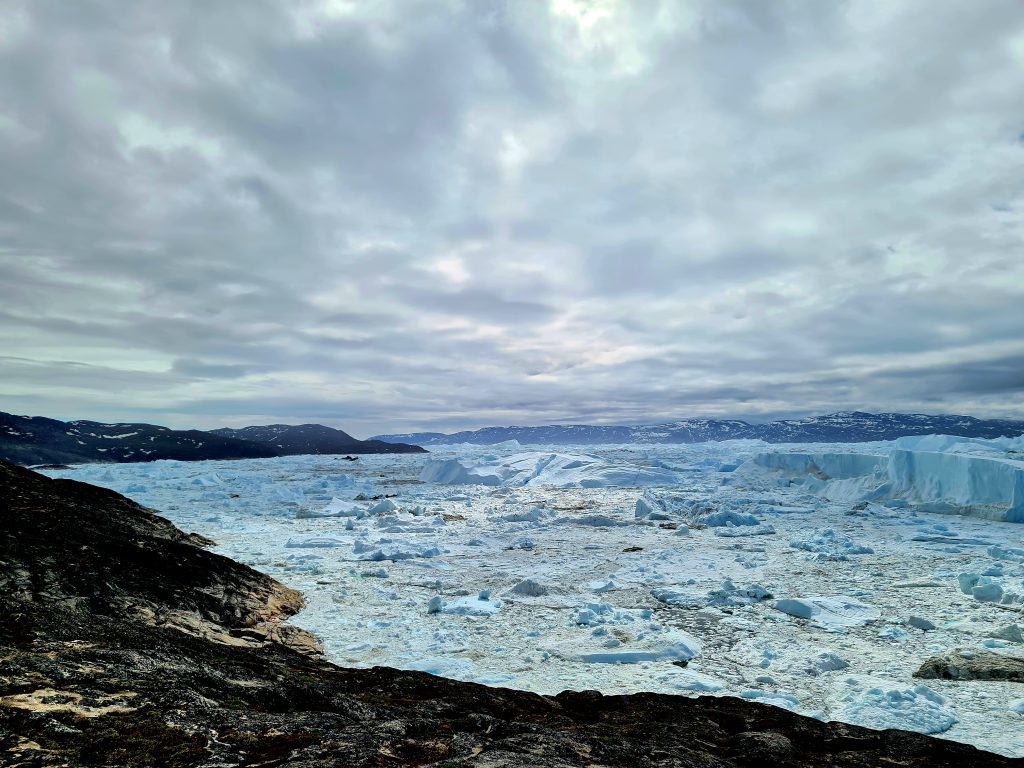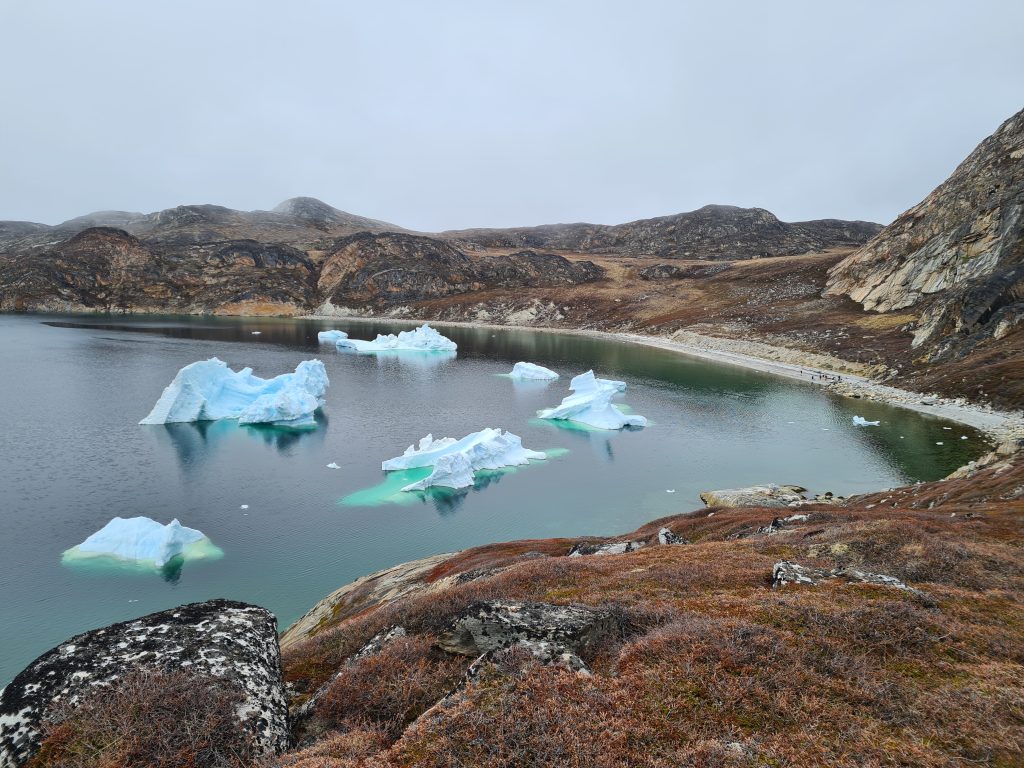Greenland. Noted for its vast tundra and immense glaciers. A remote and wild wilderness that invites superlatives. It is raw and extreme. Majestic in its barrenness. It takes no prisoners. If nature chooses to allow you to pass it will be at a price.
Was I prepared for it? Physically, yes; mentally, no.
Did I fail to manage my expectations? Absolutely.
I went out to Greenland with an unrealistic dream of how the Global Odyssey would end. A romantic vision of gliding along trail paths with a backdrop of fiords, icebergs, mountains and glaciers. All followed by rapturous and celebratory welcome over the finish line. I got the backdrop more or less right.
Nuuk. Why are you flying us to Nuuk?
300k in the opposite direction. Our introduction to Greenland.
Greenland is not an easy or straightforward country. We learned time is fluid, plans have to be flexible and patience is a necessity.

We landed in Kangerlussuak, the site of an abandoned American airbase and the only runway capable of taking large international flights. From here travellers transfer onto domestic flights that fan out to smaller airports including our destination, Ilulissat. This is where our hitch free journey ended.
The extreme and changeable weather is s significant environmental factor especially when it comes to travel. Pilots in Greenland have to undergo specialist bad weather training.
We disembarked into a crowded departure hall and café. The information boards were full of delays and cancellations. We met up with the rest of the group who should have been twenty-four hours ahead of us and already in Ilulissat. Weather had delayed their flight and they had experienced the delights of the Kangerlussuak hostel and provided the giant mosquitos Greenlandic mosquitos with a tasty snack.

Our Ilullisat flight was delayed by two hours. We decided to go out of the airport for a look around. There was not a great deal to see. It was literally a one street town. There was a supermarket, a few tourist shops and the deserted air base a short distance from the town.
The airport café provided a stomach punch of an introduction to Greenland prices. We thought Copenhagen was bad. The food vouchers that the airline had provided helped to soften the blow.
Finally, we boarded our Ilulissat flight, went through the safety briefing and were then promptly requested to disembark. A snow storm in Ilulissat meant the 250k flight north was now cancelled and we were to be flown 300k south to Nuuk. We were flummoxed. Why send us in the opposite direction? There was no accommodation left in Kangerlussuak. Armed with more vouchers for taxis, accommodation and food we were flown to a rain-soaked Nuuk also experiencing weather.

We may have been delayed a day but on a positive note we gained a visit to the capital and a further induction into the ways of Greenland. No, we couldn’t have a side order chips; no, it’s not possible to have salad with that; no, we don’t do small beers. I will gloss over the £33.00 bill for two beers and a coffee but with a tax rate of 44% hardly surprising.
Next morning, a hitch free flight took us directly to Ilulissat where the absence of snow, cloudless blue sky and sunshine gave no hint of the previous day’s storm and disruption.

We had some time available before transferring to our base at Qasigiannguit. We walked to the Icefjord for our first glimpse of the ice sheet where the Sermeq Kujalleq (Jakobshavn) glacier calves into the sea at Disko Bay. The views over a ragged vista of snow and ice and the immense log jam of ice bergs were jaw-dropping.

There are no roads in Greenland and the primarily mode of travel between settlements is by air or boat. It was time to sample the latter for a scenic journey along the coast to Qasigiannguit.
The boat navigated into the mouth of the icefiord and wove through the icebergs. Enormous, imposing white cliffs veined with bands of blue ice and moraine emerging from the ice blue water. It was gorgeous; stunning and awesome in equal measure. We relaxed, all the frustrations and anxiety of the previous day melting away.

On arrival in Qasigiannguit we joined the rest of the group in the house that would be home for the next few days. At the top of the hill from the harbour it had an open sea view with icebergs and a pair of Greenlandic huskies for neighbours.
And so, our adventure began.
No Glacier trip today
There’s too much ice.
It’s a glacier, how could there be too much ice? The answer; there was too much ice in the fiord and the boats could not get to the glacier. Monday’s activities were re-planned: a cultural walking tour of the town with museum visit followed by a fishing trip in the afternoon.
The wealth of exhibits in the small museum and the excellent narrative from our guide provided a first-rate insight into the history and rich culture of Greenland spanning from the first settlers to modern day.
Qasigiannguit was founded as a trading post in 1734 and has the oldest surviving European wooden building in Greenland. This house is part of the museum which exhibits an outstanding collection of archaeological finds from the different pre-historic cultures. The exhibitions in a second museum building exhibits covers more recent Innuit culture and the modern history of the town.

Shrimp production gave the town a period of affluence from the 1950s and a population of over 2000, but the closure of the factory in the 1990s prompted massive economic decline and halved the population. The town is now developing tourism, one of Greenland’s three economic pillars.
Reconnoitre
Hairline cracks start to appear around the edges of my dream.

Alasdair and I along, with Jenny and Ken, opted out of the fishing to do a recce of a section of the run route. A trail from the town out to the tip of a headland to the south. We set out on a clear and well-marked trail that passed the head of the inlet where the original 1734 settlement was built. The spot had proved ill-advised due to the sever winds from the mountains. The buildings were taken apart, moved and rebuilt on the north side of the bay establishing the current town.

The trail continued to another bay at the head of in iceberg studded inlet. I could see why this sheltered, pretty beach it was known as Paradise Bay.

So far, the ground had been wet and boggy in places but generally a good trail. From the bay, we ascended a steep cliff path to open tundra where we halted our recce and where any discernible path disappeared. A careful scan with binoculars revealed sparce blue stone markers off into the distance.

Not much of this headland section was going to be runnable. En-route we had also looked at, and ultimately dismissed, a small trail that had been proposed as an addition to the route. The trail head was covered by a large bank of snow and looked very wet. Tiny alarm bells started to ring. What was the rest of the route like, were there alternatives? We already knew that a loop of another headland was going to be free-form.
That evening I sat down with the guys to review the run route and the GPX which was still a work in progress just thirty-six hours before the off. The route was being pieced together using online maps and information from the local guides. My concerns over runnability remained unanswered as did my questions on the quality of the others trails. I was told that barring minor tweaks this was the only possible route.
From a camp where the Eqalunnguit fiord meets lake Qinnguata we would do a freeform loop of a headland with no trail. Hug the coastline to maximise distance. Then onto the Iliminaq trail down the fiord. This was a known, but not way-marked trail. Did this mean a clear to see trail? Ford a river and follow the yellow marked trail to Qasigiannguit and transition onto the blue marked trail to the tip of the headland. Turn around and retrace back to the camp. Frank, our local guide, and Phil would provide boat support and we would have a radio.
Frank’s advice was; ‘stay high or close to the shore, but high is better’.
There is always an element of risk planning a route not previously run and without ‘eyes-on’. There was a crackle of tension and anxiety. It was unspoken, but we all sensed a hard day at the office.
An uninvited guest
The cracks spread
Tuesday 21st June was Greenland Nation day, a public holiday and festival celebrating independence and culture. All towns and settlements hold a programme of celebrations consisting of morning songs, speeches, flag raising, a church service, local entertainment such as music, folk dancing, and displays of skills such as kayaking.
We were to spend most of the day in the town taking the opportunity to join in and experience nation day. Then we would transfer by boat to the camp on the isthmus between Eqalunnguit fiord and lake Qinnguata, where we would ready ourselves for the 100k. However, a theme was emerging. Make a plan; make another plan. Unbeknownst to me, in a single bed on the opposite side of the room, Alasdair had had a terrible night with a head-exploding headache and the shivers. ‘It’s probably just a chill from getting cold yesterday’ he said hopefully, as I dug out the lateral flow tests.





1 Comment
[…] Link back to Part 1 post. […]